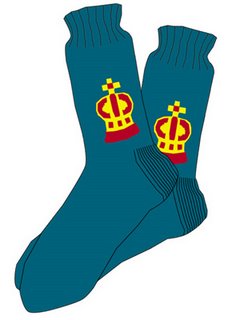Finding matching socks in the dark

What color do these socks have?
I have done a lot of research the past days about the working of the human (and rat-) memory. That convinced me of the following:
We amateurs must indeed fill our procedural memory with patterns. This has to be done by repetition. No matter how a grandmaster has done this in his youth.
Scientists admit that they have no idea why the results of the study of a grandmaster are comitted to LTM while that of amateurs are not. So we are on our own here.
I have reviewed all my old sessions at CTS during the past week. I use the "method J'adoube" for revision. In the mean time I did research on a hierarchy in patterns. I have not yet results that I can formulate, but it is a very interesting area.
I (never start with "I" for the third time, that's impolite) noticed a strange effect during the revision of problems. A problem at CTS starts with 6 seconds silence, then the computer does a move, then 3 seconds silence again and then my clock starts ticking. The first time I see a problem, I have trouble to see anything at all during the 9 seconds total silence before my clock starts ticking. Those seconds are gone with the blink of an eye. I certainly doesn't have the fast hawk eyes that Mousetrapper describes. I tend to start my investigation of a new position at the beginning, that is to say, by Adam and Eve. . .
When I repeat the problem for the 5th time however, I have time aplenty the first 6 seconds. I can finish my paper, eat a muffin, drink my coffee (yawn) before the computer makes its move. This different experience of the flow of time is just amazing.

Your sock idea gave me a kick for a new thinking about these things. Will post about this soon. Your post raises an important question: If you do heavy repetitions of a problem, will this help in recognizing the pattern faster even in novel problems? In other words: Is your rating better because you spot patterns faster or because you did so many problems that they are no longer new to you? Do you agree that the first explanation should be the true if we speak of real improvement?
ReplyDeleteFor who doesn't know what we are talking about: I wrote a comment about socks at Mouse's post.
ReplyDeleteTo Mouse:
Training results in two things:
You install a new tray AA of a new subcolor between two known trays A and B.
You develop the ability to see if a NEW sock matches A, B or AA. So you will do better in novel positions.
Hm, yes, maybe. I am not so sure if improvement is really about more complexity in the patterns. It could also be the ability to simplify the complexity down to very FEW basic patterns. Such simple decisions as target/non-target or go/no-go or attack-first/defense-first. What I want to say is that you have socks of thousands of different colors and in the end you have only two trays to put them in: the move-tray and the non-move tray.
ReplyDeletei am never board or disinterested by any of your posts. its too late to say more than that, for now, but didnt want to 'sheepishly' leave or depart from your post, without warm greetings, sir.
ReplyDeletea vacation DOES allow time for massive tactics indeed.
till next time... dk
Greetings Temposchlucker and fellow knights. I just downloaded Fritz 5.32 to be able to analyse my games in the way that La Maza describes. I have two questions; Is this program any good and how do I use the graph that La Maza describes in his book.
ReplyDeleteTake care and keep your swords up high!
SP,
ReplyDeleteI don't use Fritz myself (I use Arena) but maybe one of the other Knights knows more about it?
At the level that players like us are missing tactics, just about any chess engine will do. As long as you can put it on some kind of "infinite analysis" (I think this is the term Fritz uses), and it doesn't take too long to get 8-10 ply deep then it's certainly going to catch your tactical mistakes.
ReplyDeleteNeed proof that your engine is good enough to check your games? Try Tempo's old experiment where you set the computer to a fixed seach depth and see how low you have to put it before you win. Hint: expect it to be 2, or possibly even 1. Certainly with the right effort and carefulness you can win at higher depths, but you'll get the point.
Loomis,
ReplyDeletethe extra condition in my experiment is that you play a tempo. Simply the first move that comes to mind without correction.
Tempo. I have downloaded Arena 1.1 and it seems great, thanks for the tip. Wich engine do you recommend that I use when analysimg my games?
ReplyDeleteSamurai,
ReplyDeleteI use SOS, which is quite good. But Rufian isn't bad either.
"Method J'adoube". . .
ReplyDeleteHmmm. . .I like that! [grin]
BTW, read my latest post - I drew against an 1805 today! Huzzah!